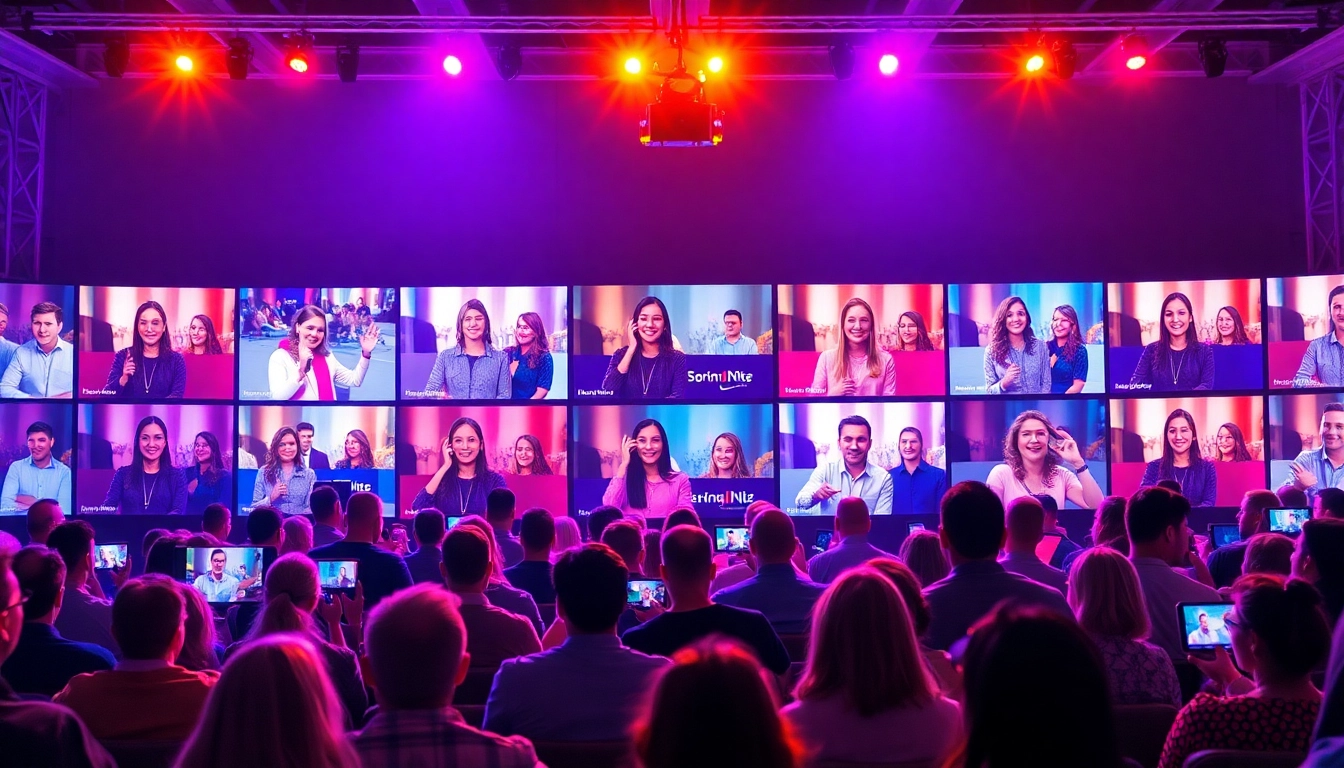Understanding the Virtual Audience System
In an increasingly digital world, the need for engaging and immersive audience experiences has never been greater. A Virtual Audience System empowers organizations, event planners, and content creators to connect with audiences in innovative ways. This technology allows for interactive experiences that can bridge geographical gaps and enhance engagement during live events.
What is a Virtual Audience System?
A Virtual Audience System refers to a digital platform or suite of technologies designed to facilitate real-time interaction between event hosts and their audiences. It typically includes features such as live streaming, audience engagement tools, and metrics tracking. These systems enable presenters to reach a larger, often global audience without the physical constraints of a traditional venue. The core idea is to simulate the atmosphere of a live event, allowing for dynamic communication and interaction.
Key Features of a Virtual Audience System
When evaluating a Virtual Audience System, it’s essential to consider the following key features:
- Live Streaming Capabilities: High-quality video and audio streaming that allows presenters to broadcast to a virtual audience in real time.
- Audience Interaction Tools: Features such as polls, Q&A sessions, and chat functionalities that promote engagement and participation.
- Analytics and Reporting: Tools to track audience engagement levels, attendee behavior, and overall event success metrics.
- Brand Customization: Ability to incorporate branding elements like logos, color schemes, and sponsorship integration within the event interface.
- Accessibility Options: Features that ensure inclusivity, including subtitles, interpreters, and various language options for diverse audiences.
Benefits of Using a Virtual Audience System
The advantages of implementing a Virtual Audience System are numerous and significant:
- Wider Reach: Organizations can extend their audience base beyond geographical limitations, allowing participation from anyone with an internet connection.
- Cost Efficiency: Reduces costs associated with physical venues, travel, and accommodation, allowing for more budget flexibility.
- Enhanced Engagement: Interactivity features can boost audience involvement, leading to richer experiences and improved retention of information.
- Data Insights: Access to detailed analytics enables organizers to understand audience preferences and improve future events.
- Flexibility and Scalability: Virtual events can be easily scaled to accommodate varying audience sizes and adjusted to align with changing circumstances.
Implementing the Virtual Audience System
Step-by-Step Guide to Setup
Setting up a Virtual Audience System may seem daunting, but following a structured approach can streamline the process:
- Define Your Goals: Clearly outline what you hope to achieve with your virtual event, whether it’s branding, lead generation, or knowledge sharing.
- Select the Right Platform: Evaluate different Virtual Audience Systems based on features, pricing, and user-friendliness.
- Plan Your Content: Develop a content strategy that includes engaging presentations, panel discussions, and interactive elements tailored to your audience.
- Coordinate Logistics: Organize technical aspects, including equipment, internet connectivity, and scheduling.
- Test Everything: Conduct dry runs to identify any technical issues and ensure that all features work seamlessly before the live event.
- Engage Your Audience: Utilize pre-event communications such as newsletters or social media to create excitement and inform attendees on what to expect.
- Execute and Monitor: During the event, monitor interactions and be prepared to adapt as necessary to enhance audience engagement.
- Follow-Up: After the event, distribute thank-you notes, surveys, and access to recordings to maintain engagement and gather feedback.
Choosing the Right Tools for Your Virtual Audience System
Selecting the right tools is crucial for the success of your Virtual Audience System. Here are some recommendations:
- Streaming Software: Platforms like Zoom, OBS Studio, or Microsoft Teams provide robust streaming solutions and audience interaction features.
- Engagement Tools: Applications such as Slido or Poll Everywhere can facilitate real-time polling and Q&A to keep your audience engaged.
- Event Management Systems: Tools like Eventbrite or Cvent can help manage registrations, ticketing, and analytics.
- Social Media Integration: Leverage platforms like Facebook Live and Instagram to broaden your reach and attract diverse audience demographics.
Common Challenges and Solutions
While implementing a Virtual Audience System, you may face challenges. Here are common issues and their solutions:
- Technical Difficulties: Ensure a robust internet connection and backup equipment. Conduct pre-event tech checks to minimize issues during the live event.
- Low Audience Engagement: Use various interactive elements like polls, chat, and gamification to keep participants engaged.
- Platform Limitations: Choose a comprehensive platform that aligns with your event goals and offers ample features for audience interaction and content delivery.
- Content Fatigue: Keep content fresh and dynamic with diverse formats, including videos, interviews, and live demonstrations to maintain interest.
Engagement Strategies with a Virtual Audience System
Interactive Elements to Enhance Audience Participation
To enhance audience participation, consider incorporating the following interactive elements:
- Live Polls and Surveys: Engage the audience by asking questions that they can answer in real time, helping to gauge interest and adjust content accordingly.
- Gamification: Introduce game-like elements, such as points or prizes, for participation in various activities, encouraging more active engagement.
- Breakout Sessions: Organize smaller group discussions to foster deeper connections among participants and allow for more personalized interactions.
- Q&A Sessions: Allow audience members to submit questions in real time, creating a dialogue that makes them feel involved and valued.
Effective Communication Techniques
To effectively communicate in a virtual setting, use these techniques:
- Clear and Concise Messaging: Be straightforward and ensure your key messages are easily digestible, avoiding complex jargon unless necessary.
- Vary Tone and Pace: Use fluctuations in your speaking voice to emphasize points and keep the audience engaged.
- Visual Aids: Support your verbal messages with relevant visuals, such as infographics or videos, to enhance comprehension and retention.
- Active Listening: Acknowledge audience comments or questions, showing that you value their input and promoting further engagement.
Real-Time Feedback Mechanisms
Gaining insights during the event can greatly enhance your understanding of audience sentiment and engagement levels. Here are some effective real-time feedback mechanisms:
- Live Chat Features: Monitor chat interactions to gauge audience reactions and maintain a pulse on engagement during the event.
- Instant Reaction Buttons: Platforms like Zoom allow participants to use reaction buttons (like thumbs up) to provide feedback on the session dynamically.
- Feedback Surveys: Distribute quick surveys during or immediately after segments of the event to capture audience opinions and adjust accordingly.
Measuring Success of Your Virtual Audience System
Key Performance Indicators (KPIs)
To evaluate the success of your Virtual Audience System, key performance indicators (KPIs) should be established and monitored. Consider the following metrics:
- Attendance Rate: Measure the percentage of registrants who attend the event, indicating overall interest and effectiveness of your promotional efforts.
- Engagement Levels: Track interaction metrics such as poll responses, chat activity, and participation rates in breakout sessions.
- Audience Satisfaction: Use surveys to assess attendee satisfaction and areas for improvement.
- Post-Event Outcomes: Evaluate conversions related to your event goals, such as leads generated or sales influenced by the event.
Analyzing Audience Interaction Data
Effective analysis of audience interaction data is essential for continuous learning and improvement. Here are several approaches to consider:
- Engagement Reports: Generate reports from your Virtual Audience System to track various metrics, helping you understand what worked well and what didn’t.
- Segmentation Analysis: Break down metrics by audience segments (e.g., demographics or attendee behavior) to identify patterns and tailor future content.
- Trend Analysis: Compare data from previous events to spot trends in audience behavior and preferences over time.
Utilizing Feedback for Continuous Improvement
Feedback should be a core part of your virtual event strategy. By collecting and analyzing feedback, organizations can identify strengths and areas for improvement. To effectively utilize feedback:
- Implement Changes: Act on constructive feedback and make necessary adjustments for future events, whether related to content, technology, or logistics.
- Engage the Audience: Inform attendees about changes made based on their feedback to show that their opinions are valued, fostering deeper loyalty.
- Continuous Education: Offer resources or follow-up content based on the questions and interests expressed during events, reinforcing learning and engagement.
Future Trends in Virtual Audience Systems
Innovations Shaping the Virtual Engagement Landscape
As technology advances, new innovations are set to transform the virtual audience experience. Some notable trends include:
- Enhanced Virtual Reality (VR) Experiences: VR technology aims to create immersive environments where audiences can interact as though they are physically present at the event.
- Augmented Reality (AR) Features: AR can provide additional content layers to enhance presentations, making them more engaging and informative.
- Advanced Networking Features: Tools that facilitate networking among attendees can enhance the experience, allowing for deeper connections.
The Role of AI and Machine Learning
Artificial Intelligence (AI) and machine learning are expected to revolutionize how virtual events are conducted:
- Personalized Content Delivery: AI can analyze attendee behavior data to tailor content recommendations in real time, enhancing user satisfaction.
- Chatbots for Engagement: AI-powered chatbots can assist with attendee inquiries and provide real-time support, improving overall event experience.
- Predictive Analytics for Planning: Machine learning can help predict engagement patterns, enabling planners to optimize event setups and content delivery.
Preparing for Next-Gen Virtual Audience Experiences
To prepare for the future of virtual audience systems, organizations should:
- Stay Updated: Keep abreast of the latest technologies and trends that can enhance virtual event experiences.
- Invest in Training: Equip teams with the necessary skills to manage advanced technologies and tools effectively.
- Embrace Flexibility: Foster an adaptable mindset to quickly integrate new methods and technologies while responding to audience needs.



